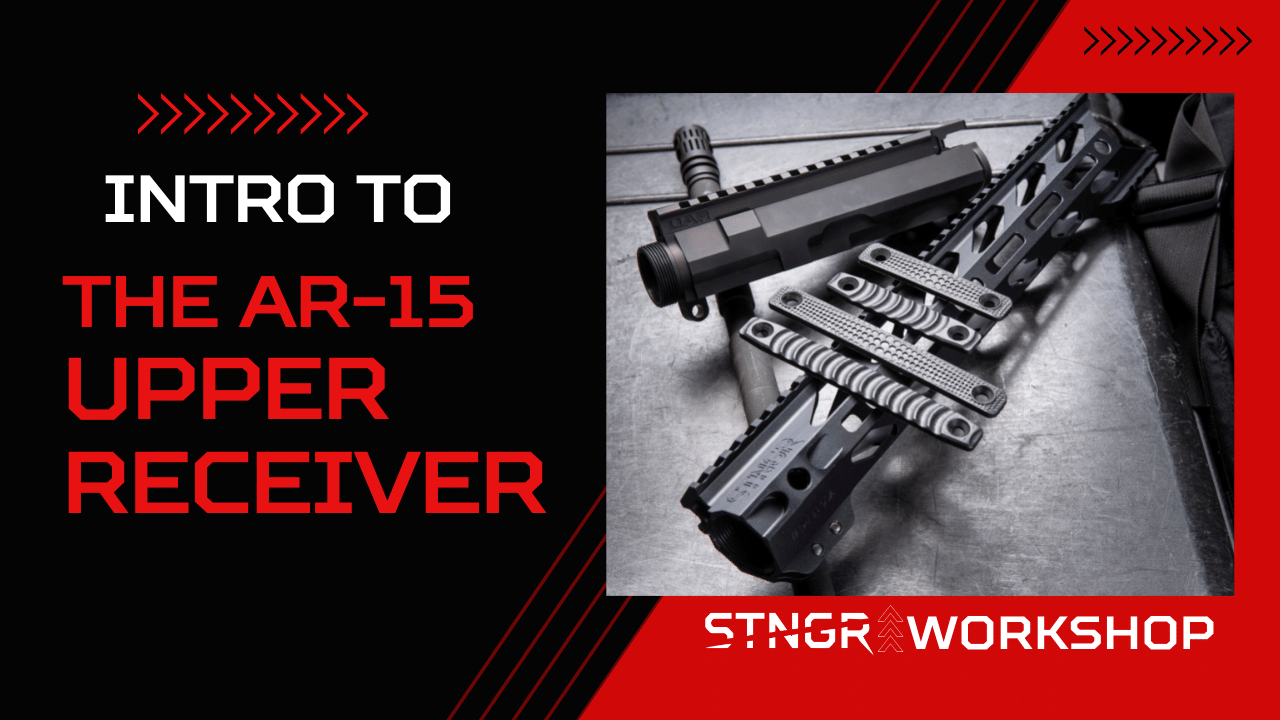Introduction to the AR-15 Upper Receiver Components
Posted by STNGR USA on Oct 7th 2022
We've talked the history of the AR-15, we've talked about its barrels. Let's talk about the upper receiver.
Table Of Contents
Click on one of the links below to jump to a specific topic in the article.
Image from Jason Baird
Intro to the AR-15 Upper Receiver
Hello and welcome to the STNGR Workshop. My name is Rick Barrett and I'm your host for the series of videos where we talk about everything in the gun community from gun accessories to gun maintenance. As we said before, we are talking the upper receiver of the AR-15 in this video. We're gonna break it down by its components; Those components being the bolt carrier group, the gas block and gas tube, the charging handle, the forward assist, and the ejection port. These are the components that are housed in the upper of the AR-15.
Anderson Manufacturing Standard AR-15 Upper Receiver. Image from Wing Tactical.
Bolt Carrier Group
Let's start our breakdown of the AR-15 upper components with the bolt carrier group. It can also be called the BCG for short. The bolt carrier group is responsible for performing the semiautomatic fire when the trigger is pulled with a series of steps in this order:
- Allowing the firing pin to strike the primer on the chambered round
- Grabbing and ejecting the spent shell casing from the fired round
- Re-cocking the hammer in the lower receiver for the next round
- Grabbing a new round from the magazine and chambering it.
As you can see there's a lot of things going on in one continuous motion. In order for that to be completed, there are a series of components inside the bolt carrier group: the firing pin, the bolt, the cam pin, extractor, and gas key. For most of us, the bolt carrier group will come included when we purchase our AR-15. However, there are a myriad of upgrades you can perform on any of these basic parts in order to get the results you're looking for. And that is a basic overall summary of what the bolt carrier group does in the AR-15 upper.
Charging Handle
The next part of the AR-15 upper that we're going to look at is right on top of the bolt carrier group and it's called the charging handle.
Now, the charging handle is the part that pulls your bolt carrier group to the rear when you need to chamber a round or to clear a malfunction. If a round doesn't fire as it should, you can simply pull on this charging handle to release the faulty shell and reload a new one. A charging handle will also let you load the first round of a new magazine if the bolt is closed. When you fire the AR-15, the charging handle remains stationary. Just like the bolt carrier group, there are a lot of different options you can pick from to upgrade your charging handle on the AR-15 platform.
Forward Assist
The next part of the AR-15 we're gonna talk about could be considered controversial depending on who you talk to. And that's called the forward assist, located on the right side of the AR-15 below the bolt carrier group. The forward assist was put on to enhance the reliability of the AR-15 platform. The function of the forward assist is to put the bolt back into battery, if for whatever reason it is not. Some believe that it is not necessary while others believe it is vital. However you think of it, now you know what the forward assist does on an AR-15.
Image from Gear-Report.com
Gas Tube and Gas Block
The next part I want to talk about on the AR-15 upper (it could have gone with the barrels but we'll keep with the upper components) is the gas tube and gas block. Your rifle relies on gas pressure to operate in the way that it was designed to. After you fire the AR-15, gas pressure forces the bolt carrier group into your buffer tube and a process that facilitates the ejection of a used round and the chambering of a new one.
Aero Precision Melonite Gas Tube
STNGR USA Low Profile Set Screw Gas Block .750" - AR15/M4
After you fire your rifle, gas moves behind the bullet that's leaving the barrel and moves through the gas port. Then it goes inside the gas block and it goes down the gas tube and exits through the bolt carrier's gas key. For the most part, the gas blocks are installed on the upper barrel inside the hand guard. The gas tube connects to the block on the upper receiver. And that's the gas tube and gas block of the AR-15.
Aero Precision .750 Low Profile Gas Block with Aero Logo, Nitride w/ Pinned SS Carbine Gas Tube
Ejection Port Cover
The last part of the AR-15 rifle that I want to talk to you about is the part that helps keep the upper of your AR-15 clean. It's the ejection port cover. Now when this ejection port cover is closed it will prevent dirt, dust, and other debris from getting into the AR-15 and making it dirty. You want to keep your AR-15 upper as clean as possible, so that way it runs as flawlessly as possible.
Final Thoughts
And that's it for today's video. We've talked about the AR-15 upper components: the bolt carrier group, the ejection port cover, the forward assist, the charging handle, the gas tube, and gas block. So now you know all the inside components of the AR-15 upper. Thank you for stopping by the STNGR Workshop. My name is Rick Barrett. I hope you enjoyed this video and I'll talk to you soon.


